
- Usage in publication:
-
- Talpa bed
- Modifications:
-
- Original reference
- Dominant lithology:
-
- Limestone
- Clay
- Marl
- AAPG geologic province:
-
- Bend arch
- Llano uplift
Summary:
Pg. 421, 428. Talpa bed in Albany division. Nearly all limestone, mostly hard and massive, of gray, bluish, and yellowish colors and rather uneven texture. Fossiliferous. Thickness 200 to 300 feet. Member of Albany division [Albany is uppermost of 5 Carboniferous divisions of Cummins, 1891]. Underlies Paint Rock bed and overlies Grape Creek bed. Age is possibly Permian.
[Named from Talpa, on Gulf, Colorado and Santa Fe RR, Coleman Co., Colorado River region, central TX.]
Source: Publication; US geologic names lexicon (USGS Bull. 896, p. 2112).
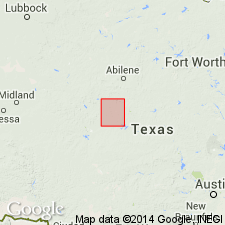
- Usage in publication:
-
- Talpa formation
- Modifications:
-
- Revised
- AAPG geologic province:
-
- Permian basin
Summary:
Pg. 36. Talpa formation. Redefined Paintrock by removing from its base 70 feet of beds, which they transferred to Talpa formation. They gave thickness of Talpa as 400 feet. (See 1918 entry under Paint Rock bed.) [Age is Permian.]
Source: US geologic names lexicon (USGS Bull. 896, p. 2112).
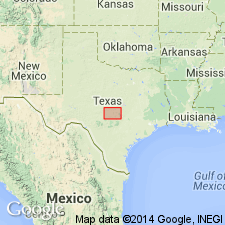
- Usage in publication:
-
- Talpa limestone member
- Modifications:
-
- Revised
- AAPG geologic province:
-
- Bend arch
Summary:
Pg. 197-198. Talpa limestone is top member of Clyde formation (of Wichita group). Overlies Grape Creek shale and limestone bed. [Age is Permian.]
Source: US geologic names lexicon (USGS Bull. 896, p. 2112).

- Usage in publication:
-
- Talpa limestone
- Modifications:
-
- Revised
- AAPG geologic province:
-
- Bend arch
- Llano uplift
Summary:
Pg. 169. Talpa limestone of Drake is top bed of Clyde formation. [Age is Permian.]
Source: Publication; US geologic names lexicon (USGS Bull. 896, p. 2112).
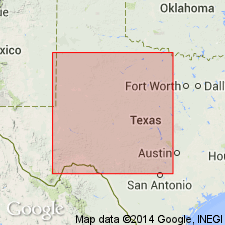
- Usage in publication:
-
- Talpa formation
- Modifications:
-
- Revised
- AAPG geologic province:
-
- Bend arch
Summary:
Pg. 66 (fig. 1). Talpa formation of Clyde group. Rank raised to formation in the Clyde herein given group status. [Age is Permian.]
Source: US geologic names lexicon (USGS Bull. 1200, p. 3815).
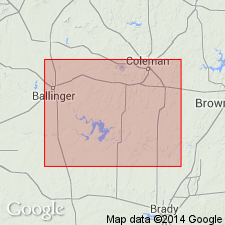
- Usage in publication:
-
- Talpa limestone member*
- Modifications:
-
- Mapped
- AAPG geologic province:
-
- Bend arch
Summary:
Sheet 2. Talpa limestone member of Clyde formation. In Colorado River Valley, constitutes upper two-fifths of formation. Consists of even, relatively thin beds of limestone and shale similar to underlying Grape Creek member but differs in the harder, more brittle nature of the beds and the commonly slightly darker color. Thickness about 180 feet. Underlies Lueders limestone. Division of the Clyde into members in this area is not as natural as in the area north of Abilene; in area mapped herein, units might appropriately be treated as formations. Type "Paint Rock" in Concho County has been traced into type exposure of the Talpa limestone; "Paint Rock" is a synonym for Talpa limestone and preference in nomenclature is given latter term. Age is Early Permian (Leonard?).
Source: Publication; US geologic names lexicon (USGS Bull. 1200, p. 3815).
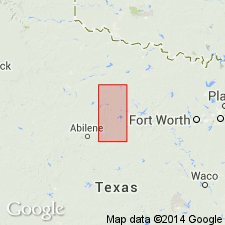
- Usage in publication:
-
- Talpa limestone member
- Modifications:
-
- Areal extent
- AAPG geologic province:
-
- Bend arch
Summary:
Pg. 275-276. Talpa limestone member of Clyde formation. Geographically extended into Brazos River Valley where it is 45 to 55 feet thick and consists of alternating gray limestone and shale beds with less siltstone. Separated from underlying Grape Creek limestone member by unnamed shale member and from overlying Lueders limestone by an unnamed shale interval. [Age is Permian.]
Source: US geologic names lexicon (USGS Bull. 1200, p. 3815).
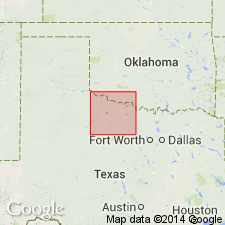
- Usage in publication:
-
- Talpa Formation
- Modifications:
-
- Mapped
- AAPG geologic province:
-
- Bend arch
Summary:
Talpa Formation of Albany Group. Shale and limestone, 70 to 100 feet thick. Equivalent to part of Waggoner Ranch Formation (new) of Wichita Group. Underlies Lueders Formation and overlies Grape Creek Formation, both of Albany. Includes lower part of Lueders Formation and upper part of Clyde Formation of earlier workers. Fossils. Age is Early Permian (Leonard).
Geographic extent arbitrarily placed along North Fork of Little Wichita River; [notable exposures south of Wichita River, in Baylor and Throckmorton Cos.]
Source: Publication.
For more information, please contact Nancy Stamm, Geologic Names Committee Secretary.
Asterisk (*) indicates published by U.S. Geological Survey authors.
"No current usage" (†) implies that a name has been abandoned or has fallen into disuse. Former usage and, if known, replacement name given in parentheses ( ).
Slash (/) indicates name conflicts with nomenclatural guidelines (CSN, 1933; ACSN, 1961, 1970; NACSN, 1983, 2005, 2021). May be explained within brackets ([ ]).

